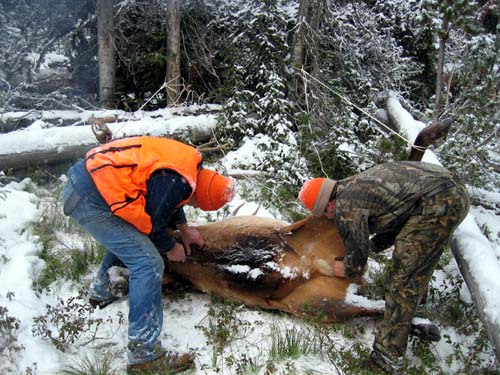
(11/3/03)
Steve Sanders bagged the elk shown below, and on Nov 3rd we boned it and packed it out (it was about 5 miles in from the pickup). Here are some pictures, along with a description of how this is done. Technically this is not "field dressing", but instead "boning out the elk" for packing out.
Below they are about to start. Chip on the left and Steve on the right. Notice we have tied the feet to the trees behind the elk to keep it propped up like this. The idea is to skin one side, take the meat, then roll the elk over to the other side, skin it, take the meat, and never actually take the guts out or field dress it. This saves time and effort, and doesn't waste very much meat.
Now they have started skinning. Bruce is helping by pulling the skin tight while Steve slices away at the layer of fat separating the skin from the carcass.
Below is the first leg to come off. One person lifts while another finds the joints and cuts it free.
Another shot as the first leg (a hind leg) comes free. Notice they have laid out the hide as a surface to put carved meat until it can be bagged for carrying out.
That's me putting my weight behind the antlers to straighten out the neck so Steve can skin up as high as needed.
Here the second leg (a front leg this time) has been started, trying to cut it free.
As we get enough meat for a pack trip, Bruce decides to make a trip to the pickups. This is a 10 ***MILE*** round trip, and Bruce will be the only person to do two of these trips today. He's a madman. Below Bruce first puts the meat in white trash bags, then wraps it in a tarp, then straps it to a pack board.
Here is the whole camp working. It took 3 hours to hike in (we started hiking in at 6:15am) and we reached the elk at 9:15am. Bruce took the first load of meat out at 11:30am, then returned by 4pm, then he eventually walked out at night by flashlight at about 7:45pm, having put in a 14 hour day walking 20 miles with 80 pound packs up and down insane Montana hillsides. Bruce is a madman. Also notice we started this whole process by building a fire. This is absolutely necessary to keep warm during this 4-6 hour butchering job. The guys doing the skinning take frequent breaks to warm their hands by the fire.
Here Bruce is departing on his first run.
Chip is taking out the "back strap" here. This is the very best cut of meat on the elk, and it's enormous on this big elk.
Below is a picture of the elk half way through. The side up has been totally skinned and the two legs removed, we're ready to roll it over and do the other side. This took about 2 hours of work to get this far.
At half way, Steve and Chip sharpen their knives which have dulled already. This is a sharpen stone with embedded diamonds Steve uses.
Now the elk has been rolled over on it's other side. It took 3 of us to roll it over, plus the ropes tied to the trees. We even have a block and tackle along if needed.
Here three legs have been removed, and it's almost done.
A shot of removing the last hind leg.
Steve wants the head to mount it, so he must cut it off, while preserving enough fur for the stuffed mount.
Steve gets the head free, and drags it away.
Here is the final carcass. There are no more "cuts" of meat left worth taking here, but there is some more hamburger (ground elk) material you can take from the neck, so they work on this a little more after this picture was taken. Notice they never split the stomach open and emptied the guts (which would be a traditional "field dressing"). This saved them time.
In the picture below, the head has been cleaned up, the extra pelt rolled up and bagged with a garbage back, getting ready for the pack out.
Here is Steve with the 100 pound head on his back, ready for the 5 mile walk out. He has wrapped "hunters marker tape" all around the antlers so some other hunter doesn't think he's an elk and shoot him.